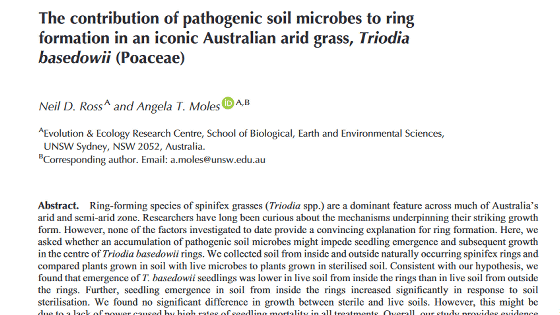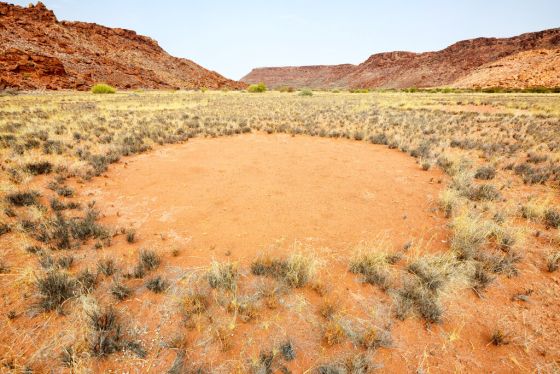What is the mechanism by which plants grow in a ring shape and form a 'fairy circle'?

In the wilderness of Australia, you can observe a phenomenon called 'fairy circle' in which
The contribution of pathogenic soil microbes to ring formation in an iconic Australian arid grass, Triodia basedowii (Poaceae) --BT20122
(PDF link) https://www.publish.csiro.au/bt/pdf/BT20122

Fairy Circles in Australia May Be Due to Microbes, Study Says --The New York Times
https://www.nytimes.com/2021/04/12/science/fairy-circles-australia.html
Spinifex littoralis inhabiting Australia initially grow in small clusters, but then when new strains sprout outwards, the central part withers and forms a ring. By repeating this, the spinifex littorium forms a large fairy circle.

Angela Malls , an ecology researcher at the University of New South Wales , said, 'Is the central part dry?' We have tested hypotheses such as 'whether the soil is compressed' and 'whether some insects are involved', but we have not been able to obtain any valid clues as to why the fairy circle is formed.
Mr. Mols recently heard that 'in the wetlands of Europe, the central part died due to the influence of soil pathogens, and the plants grew in a ring shape.' May be involved. ' Then, in order to test the hypothesis, 'Soil inside the fairy circle (Inner)' and 'Soil outside the fairy circle (Outer)' were brought back to the laboratory, sterilized, and then the seeds of fairy tales were planted and germinated. I observed whether to do it.

The graph below shows the percentage of germination on the vertical axis, where each bar did not sterilize the 'inner of the fairy circle' and the 'outer of the fairy circle' (outer). It shows the germination rate when sterilized (orange) and (white). If you look at the graph, you can see that the germination rate is higher when the 'inner inside the fairy circle' is sterilized than when it is not sterilized. From this result, Mr. Malls speculates that 'inside the fairy circle, some microorganisms are inhibiting the germination of spinifex littoralis.'

Conversely, it was also found that when 'Outer' of the 'Fairy Circle' was sterilized, the germination rate was lower than when it was not sterilized. From this, Mr. Malls speculates that 'the outside of the fairy circle is inhabited by microorganisms that help the sprouting of spinifex littoralis.'
In addition, to investigate the effect of bacteria on the grown spinifex, Mores planted the grown strains instead of the spinifex seeds under the same conditions as the observations above and observed the growth. As a result, it was found that the presence or absence of sterilization did not affect the growth both inside and outside the fairy circle.

'Plants require a lot of energy to germinate, so they are strongly influenced by microorganisms during germination, but less affected by microorganisms after germination,' said Molles.
This study revealed that microorganisms are involved in the formation of fairy circles, but there are still many unclear points regarding the types of bacteria. 'Identifying the type of microorganism is of sufficient value in understanding the spinifex littorium ecosystem,' said Molles, who is eager to proceed with a detailed analysis.
Related Posts:
in Science, Posted by log1o_hf







